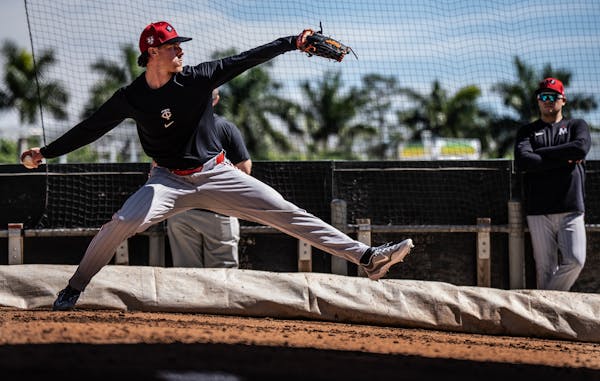FORT MYERS, FLA. – Carlos Santana has played for six major league teams in his career, and at each stop, he wore No. 41. It's a tribute, he said, to five-time All-Star Victor Martinez, the Venezuelan slugger who played for 16 seasons, most of them also with No. 41 on his back.
"In the minor leagues [while with Cleveland], he taught me a lot, every year. He was my favorite player," Santana said, so when he arrived in the majors the year after Martinez had moved on to Boston, he asked for his friend's old number. "The last time I saw him, we talked about that. And he was very proud and happy for it, and for me."
Who could put a price on that kind of loyalty, on respect so sincere?
Turns out, Major League Baseball can. And in this case, the tab runs to more than $225,000.
That's the estimated value of all the Twins jerseys, caps, T-shirts and replica uniforms in MLB Licensing's inventory, and those of the sport's retail partners, that already have No. 41 on them.
The problem is, all that merchandise has Joe Ryan's name on it, too, since Ryan, one of the team's most popular and marketable players, has worn the number for the past two seasons.
Buy those thousands of Joe Ryan souvenirs and make us whole, MLB told Santana, or find a new number. Ryan has to keep wearing the number that's in the program and on store shelves.
"It's the first time that's happened to me," said Santana, who, though he has changed teams six times over the past six seasons, has always landed with a team that had his preferred number available. "I don't want to pay all that money for using 41. But it's OK. [Ryan] has played here for a while. I'm not upset."
Still, it's embarrassing for a team not to be able to fulfill the preferences of their veteran players, especially one with 14 years of experience like Santana.
Sign up for our Twins Update newsletter
But MLB, which charges $354.99 on the Twins' website for authentic jerseys, is mindful of the cost of obsolete inventory on shelves, not to mention the cost of annoying fans whose expensive wearable is suddenly rendered inaccurate.
The league in recent years began enforcing a rule, negotiated into the collective bargaining agreement with the players' union, that says number changes must be requested by July 31 of the previous season. Exceptions will be granted, the CBA says, if the player changes teams — in this case, it was Ryan who technically was seeking a new number — or if "the player (or someone on his behalf) purchases the existing finished-goods inventory" with that number.
The number has sentimental value to him, too, Ryan said.
"My number for a long time [in the minor leagues] was 14. But when I got here, Kent Hrbek was sort of in the way there," Ryan said, given that the Twins retired Hrbek's old number in 1995. "So I just reversed it. And Tom Seaver wore 41. Him being a California guy like me, that was really cool."
Ryan, though, understands the perquisites that come with seniority, and said he was willing to let Santana have it. Santana even broached the subject of compensation for Ryan, traditional in such veteran-newcomer bargaining. (Though memorably, Eddie Rosario refused to let Josh Donaldson take his No. 20 when the Twins acquired the veteran third baseman in 2020.)
"A veteran guy comes in, he's got more than a decade in the majors and it's going to make him super-happy, I can switch numbers for a year or two. I told him that," Ryan said. "Can't blame him for second thoughts when he saw the cost, though."
A few Twins have run into this problem in the past. Carlos Correa said he tried to change his number a few years ago while with the Astros but was also told that MLB had too much merchandise with his No. 1 on it to approve the switch. Correa eventually changed to No. 4 when he signed with the Twins, even though Nick Gordon said he was prepared to give up No. 1.
Two years ago, Gary Sánchez asked for his Yankees number, 24, when he was traded to Minnesota, which was then worn by second-year outfielder Trevor Larnach. MLB interceded at first, billing the players nearly $25,000 for merchandise. The Twins found that bizarre, given that Larnach had played only 79 games by that time, and protested to the league.
Lawyers on both sides got involved, and MLB finally dropped its objection, allowing Larnach to switch first to 13 for 2022, and then to 9 last year, when Joey Gallo arrived to wear his preferred (and seemingly unlucky) number.
This time, though, the bill was so high that Santana decided not to pursue the matter. He chose No. 30, his first number in professional baseball.
"It's too bad, but I understand it," Santana said. "So 41 will still be in my heart, always. But I'll be happy with No. 30, too."

Taylor Pendrith rolls into second-round lead at 3M Open
Coughlin holds into CPKC Women's Open lead; Canadian star Henderson derailed by closing bogeys

